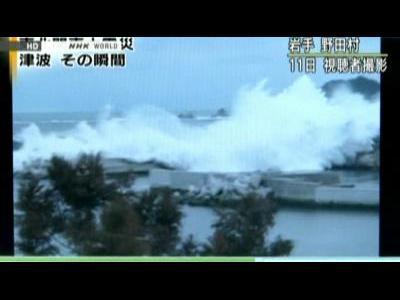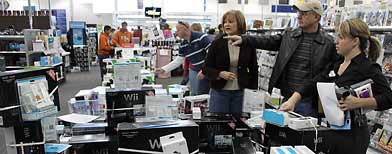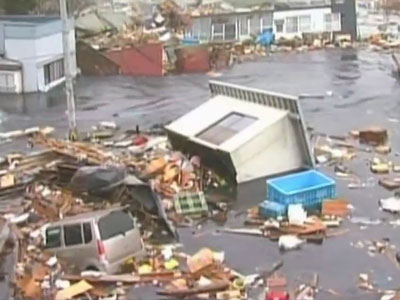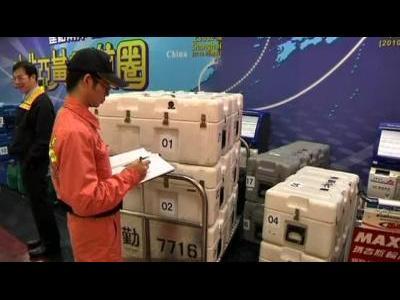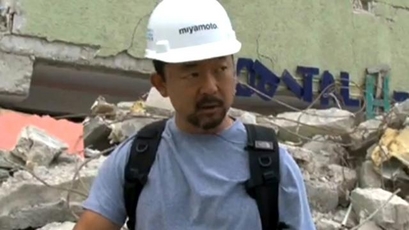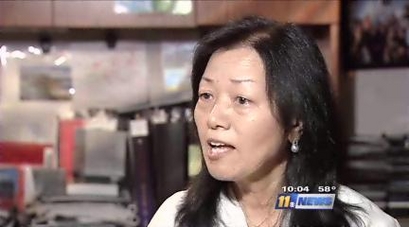SOMA, Japan – High levels of radiation leaked from a crippled nuclear plant in tsunami-ravaged northeastern Japan after a third reactor was rocked by an explosion Tuesday and a fourth caught fire in a dramatic escalation of the 4-day-old catastrophe. The government warned 140,000 people nearby to stay indoors to avoid exposure.
Tokyo also reported slightly elevated radiation levels, but officials said the increase was too small to threaten the 39 million people in and around the capital, about 170 miles (270 kilometers) away.
In a nationally televised statement, Prime Minister Naoto Kan said radiation has spread from four reactors of the Fukushima Dai-ichi nuclear plant in Fukushima state, one of the hardest-hit in Friday's 9.0-magnitude earthquake and the ensuing tsunami that has killed more than 10,000 people, plunged millions into misery and pummeled the world's third-largest economy.
Officials just south of Fukushima reported up to 100 times the normal levels of radiation Tuesday morning, Kyodo News agency reported. While those figures are worrying if there is prolonged exposure, they are far from fatal.
Kan and other officials warned there is danger of more leaks and told people living within 19 miles (30 kilometers) of the Fukushima Dai-ichi complex to stay indoors to avoid exposure that could make people sick.
"Please do not go outside. Please stay indoors. Please close windows and make your homes airtight," Chief Cabinet Secretary Yukio Edano told residents in the danger zone. "Don't turn on ventilators. Please hang your laundry indoors."
"These are figures that potentially affect health. There is no mistake about that," he said.
Weather forecasts for Fukushima were for snow and wind from the northeast Tuesday evening, blowing southwest toward Tokyo, then shifting and blowing west out to sea. That's important because it shows which direction a possible nuclear cloud might blow.
The nuclear crisis is the worst Japan has faced since the atomic bombing of Hiroshima and Nagasaki during World War II. It is also the first time that such a grave nuclear threat has been raised in the world since a nuclear power plant in Chernobyl, Ukraine exploded in 1986.
Some 70,000 people had already been evacuated from a 12-mile (20-kilometer) radius from the Dai-ichi complex and about 140,000 remain in the zone for which the new warning was issued.
Workers were striving to stabilize three reactors at the power plant that exploded in the wake of Friday's quake and tsunami, after losing their ability to cool down and releasing some radiation. A fourth reactor that was shut down caught fire on Tuesday and more radiation was released, Edano said.
The fire was put out. Even though the fourth reactor was shut down, the fire there was believed to be the source of the elevated radiation.
"It is likely that the level of radiation increased sharply due to a fire at Unit 4," Edano said. "Now we are talking about levels that can damage human health. These are readings taken near the area where we believe the releases are happening. Far away, the levels should be lower."
He said another reactor whose containment building exploded Monday had not contributed greatly to the increased radiation.
Officials said 50 workers, all of them wearing protective radiation gear, were still trying to put water into the reactors to cool them. They say 800 other staff were evacuated. The fires and explosions at the reactors have injured 15 workers and military personnel and exposed up to 190 people to elevated radiation.
In Tokyo, slightly higher-than-normal radiation levels were detected Tuesday but officials insisted there are no health dangers.
"The amount is extremely small, and it does not raise health concerns. It will not affect us," Takayuki Fujiki, a Tokyo government official said.
Kyodo reported that radiation levels nine times higher than normal were briefly detected in Kanagawa prefecture near Tokyo and that the Tokyo metropolitan government said it had detected a small amount of radioactive materials in the city's air.
Japanese government officials are being rightly cautious, said Donald Olander, professor emeritus of nuclear engineering at University of California at Berkeley. He believed even the heavily elevated levels of radiation around Dai'ichi are "not a health hazard." But without knowing specific dose levels, he said it was hard to make judgments on the evacuation orders.
"Right now it's worse than Three Mile Island," Olander said. But, he said, it's nowhere near the levels released during Chernobyl.
On Three Mile Island, the radiation leak was held inside the containment shell — thick concrete armor around the reactor. The Chernobyl reactor had no shell and was also operational when the disaster struck. The Japanese reactors automatically shut down when the quake hit and are encased in containment shells.
Olander said encasing the reactors in a concrete sarcophagus — the last-ditch effort done in Chernobyl — is far too premature. Operators need to wait until they cool more, or risk making the situation even worse.
The death toll from last week's earthquake and tsunami jumped Tuesday as police confirmed the number killed had topped 2,400, though that grim news was overshadowed by a deepening nuclear crisis. Officials have said previously that at least 10,000 people may have died in Miyagi province alone.
Millions of people spent a fourth night with little food, water or heating in near-freezing temperatures as they dealt with the loss of homes and loved ones. Asia's richest country hasn't seen such hardship since World War II.
Hajime Sato, a government official in Iwate prefecture, one of the hardest-hit, said deliveries of supplies were only 10 percent of what is needed. Body bags and coffins were running so short that the government may turn to foreign funeral homes for help, he said.
Though Japanese officials have refused to speculate on the death toll, Indonesian geologist Hery Harjono, who dealt with the 2004 Asian tsunami, said it would be "a miracle really if it turns out to be less than 10,000" dead.
The 2004 tsunami killed 230,000 people — of which only 184,000 bodies were found.
The impact of the earthquake and tsunami on the world's third-largest economy helped drag down the share markets. The benchmark Nikkei 225 stock average plunged for a second day Tuesday, nose-diving more than 12 percent to 8,422.21 while the broader Topix lost 13 percent.
To lessen the damage, Japan's central bank injected $61.2 billion Tuesday into the money markets after pumping in $184 billion on Monday.
Initial estimates put repair costs in the tens of billions of dollars, costs that would likely add to a massive public debt that, at 200 percent of gross domestic product, is the biggest among industrialized nations.
In a bid to stop the reactors at the nuclear plant from melting down, engineers have been injecting seawater as a coolant of last resort.
Yuta Tadano, a 20-year-old pump technician at the Fukushima power plant, said he was on the second floor of an office building in the complex when quake hit.
"It was terrible. The desks were thrown around and the tables too. The walls started to crumble around us and there was dust everywhere. The roof began to collapse.
"We got outside and confirmed everyone was safe . Then we got out of there. We had no time to be tested for radioactive exposure. I still haven't been tested," Tadano told The Associated Press at an evacuation center outside the exclusion zone.
"We live about 10 kilometers (6 miles) from the facility. We had to figure out on our own where to go," said Tadano, cradling his 4-month-old baby, Shoma. "I worry a lot about fallout. If we could see it we could escape, but we can't."
The Dai-ichi plant is the most severely affected of three nuclear complexes that were declared emergencies after suffering damage in Friday's quake and tsunami, raising questions about the safety of such plants in coastal areas near fault lines and adding to global jitters over the industry.
___
Yuasa reported from Tokyo. Associated Press writer Elaine Kurtenbach contributed to this report.
http://news.yahoo.com/s/ap/20110315/ap_on_bi_ge/as_japan_earthquake







